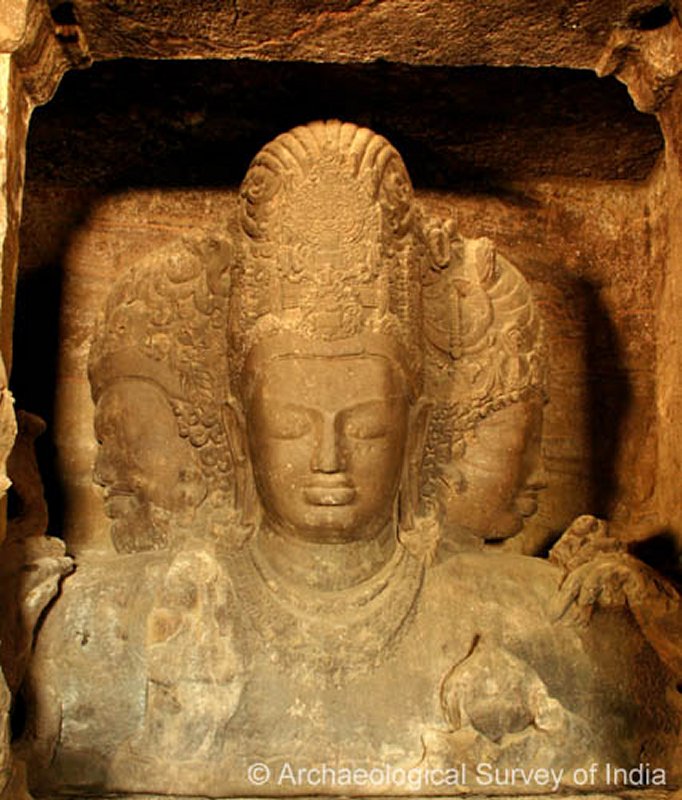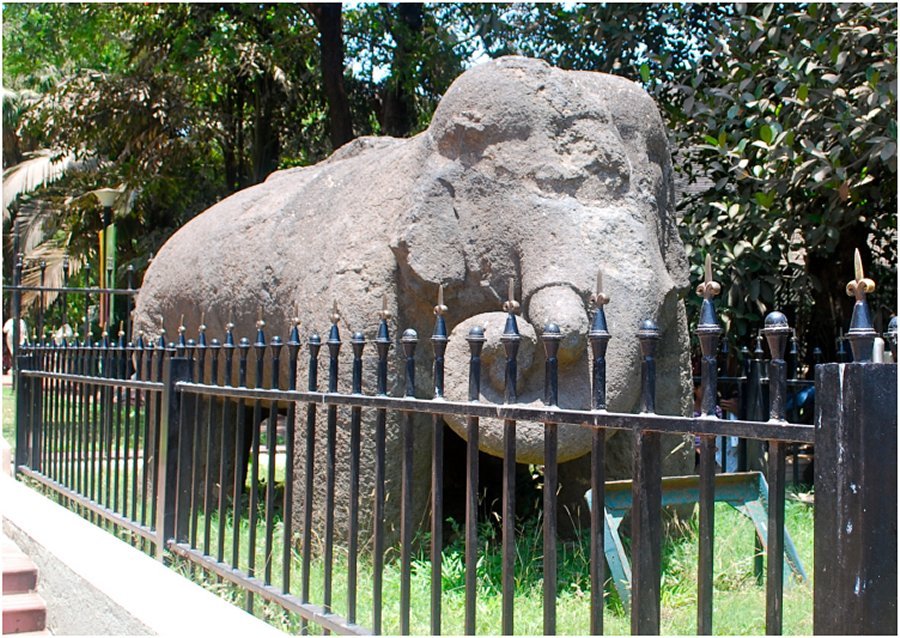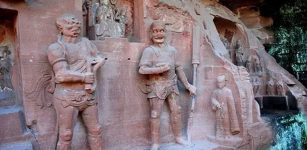Ancient Complex Of Elephanta Caves In India
A. Sutherland - AncientPages.com - The Elephanta Caves, believed to be dated to about the 7th century, represent a complex of ancient cave temples on Elephanta Island, located 10 km from the Gateway of India at Mumbai. These structures represent some of the most striking collections of rock-art in India.

Trimurti Sculpture - Elephanta Caves, India - The sculpture is 20 ft (6.1 m) high.; it is a colossal bust of the three forms of Shiva. Photo credits: ASI
The complex consists of two groups of caves—the first is a large group of five Hindu caves with rock-cut stone sculptures. The main cave is famous for its carvings depiciting the glorious Shiva, who is displayed in various forms and act ions. The cave consists of a square plan mandapa whose sides measure about 27 m.
The second (to the east) is a smaller group of two Buddhist caves with one of which is unfinished, and several cisterns.
The place - still worshipped by the locals - is dedicated to Lord Shiva.
The island, which covers an area of approximately 7 km, was initially called Gharapuri (literally "the city of caves"); later, the Portuguese renamed the island after they found a colossal stone elephant near their landing place.
Elephanta Island came under the dominion of at least half a dozen different powers that ruled this region from 400 BC to modern times.
Before the Hindu caves were excavated, the island was a Buddhist center. The remains of the Buddhist stupas in Elephanta probably date to the early phase of Buddhism (about the 2nd century BC.)
 Elephanta Caves, India - The island of Elephanta, the glorious abode of Lord Shiva and an epitome of Hindu cave culture, consists of seven caves on an island in the Sea of Oman close to Mumbai which, with their decorated temples and the images from Hindu mythology, bear a unique testimony to a civilization that has disappeared. Here, Indian art has found one of its most perfect expressions, particularly in the huge high reliefs in the main cave. Image source - Ministry of Culturen - Government of India
Elephanta Caves, India - The island of Elephanta, the glorious abode of Lord Shiva and an epitome of Hindu cave culture, consists of seven caves on an island in the Sea of Oman close to Mumbai which, with their decorated temples and the images from Hindu mythology, bear a unique testimony to a civilization that has disappeared. Here, Indian art has found one of its most perfect expressions, particularly in the huge high reliefs in the main cave. Image source - Ministry of Culturen - Government of India
The Buddhists, the first to carve temples from mountains, were followed by the Hindus. Every Hindu temple primarily worships one Hindu god, and the Elephanta Caves were for worshipping Shiva.
The statues carved on the walls of the Elephanta Caves are giant (about 20 feet high). They were elaborate, centering on a scene in Shiva's life featuring Shiva, his wife, and other influential personalities.
The date of the famous Elephanta Caves is still very much debated and varies from the 6th century to the 8th century according to the experts. There are many theories regarding the beginnings of the Elephanta Caves. Most of them propose that they were built from 450 to 750 AD.
Interestingly, this period also marks the decline of Buddhism in India and the revival of the Brahmanical traditions (ancient Indian religious traditions that have their beginnings in the early Vedic religion) in the country.

The Elephant statute from which Elephanta Island gets its name is now displayed in the Bhau Daji Lad Museum in Mumbai.
The most impressive of all the caves is Cave 1, which represents the evolved Brahmanical rock-cut architecture and displays several unique and lively sculptures.
The cave has a main entrance on the north with two other openings on the east and west, respectively, and a central hall with six rows (with six in each row) of pillared columns, six in each row except on the western corner, where a shrine contains a collection of rock art related to Shiva.
The temple dedicated to Lord Shiva is declared a UNESCO World Heritage Site.
Written by – A. Sutherland - AncientPages.com Senior Staff Writer
Updated on Oct 16, 2023
Copyright © AncientPages.com All rights reserved. This material may not be published, broadcast, rewritten or redistributed in whole or part without the express written permission of AncientPages.com
Expand for referencesMore From Ancient Pages
-
 Dazu Rock Statues Of Clairvoyance And Clairaudience: Is One Of them Holding A Snake Or ‘Telephone Receiver” In His Hand?
Archaeology | Mar 8, 2017
Dazu Rock Statues Of Clairvoyance And Clairaudience: Is One Of them Holding A Snake Or ‘Telephone Receiver” In His Hand?
Archaeology | Mar 8, 2017 -
 Ancient DNA Has Rewritten Early Japanese History
Archaeology | Sep 17, 2021
Ancient DNA Has Rewritten Early Japanese History
Archaeology | Sep 17, 2021 -
 2500-Year-Old Objects Made From Goat Bones Discovered In Turkey’s City Of Aigai
Archaeology | Sep 17, 2020
2500-Year-Old Objects Made From Goat Bones Discovered In Turkey’s City Of Aigai
Archaeology | Sep 17, 2020 -
 Meskiaggasher: Legendary Founder Of The First Dynasty Of Uruk Who ‘Entered The Sea And Disappeared’
Featured Stories | Apr 20, 2021
Meskiaggasher: Legendary Founder Of The First Dynasty Of Uruk Who ‘Entered The Sea And Disappeared’
Featured Stories | Apr 20, 2021 -
 Boobrie: Shape-Shifting Mythical Horror Bird From Scottish Highlands
Featured Stories | Feb 9, 2017
Boobrie: Shape-Shifting Mythical Horror Bird From Scottish Highlands
Featured Stories | Feb 9, 2017 -
 Isotope Analysis Helps Tell The Stories Of Aboriginal People Living Under Early Colonial Expansion
Archaeology | May 2, 2023
Isotope Analysis Helps Tell The Stories Of Aboriginal People Living Under Early Colonial Expansion
Archaeology | May 2, 2023 -
 Vindelev Treasure Re-Writes Ancient History – World’s Oldest Runic Inscription Of God Odin Found On Ancient Gold Pendants
Archaeology | Mar 8, 2023
Vindelev Treasure Re-Writes Ancient History – World’s Oldest Runic Inscription Of God Odin Found On Ancient Gold Pendants
Archaeology | Mar 8, 2023 -
 407-Million-Year-Old Plant Fossil Challenges Long-Held Theory On Fibonacci Spirals Found In Nature
Evolution | Jun 22, 2023
407-Million-Year-Old Plant Fossil Challenges Long-Held Theory On Fibonacci Spirals Found In Nature
Evolution | Jun 22, 2023 -
 Tracing Footsteps Of Giants In Africa – Obscure Past Of Mzoura Stones
Civilizations | Oct 18, 2015
Tracing Footsteps Of Giants In Africa – Obscure Past Of Mzoura Stones
Civilizations | Oct 18, 2015 -
 Gigantic Asipatra: Terrifying Mythical Monster Bird In Hindu Beliefs
Featured Stories | Jun 14, 2017
Gigantic Asipatra: Terrifying Mythical Monster Bird In Hindu Beliefs
Featured Stories | Jun 14, 2017 -
 Solar Cult Complex In The Temple Of Hatshepsut In Deir El-Bahari Reconstructed
Archaeology | Mar 2, 2015
Solar Cult Complex In The Temple Of Hatshepsut In Deir El-Bahari Reconstructed
Archaeology | Mar 2, 2015 -
 Mysterious Ancient Ruins Of Engaruka – Why Was The Site Abandoned?
Featured Stories | Apr 18, 2017
Mysterious Ancient Ruins Of Engaruka – Why Was The Site Abandoned?
Featured Stories | Apr 18, 2017 -
 Undersea Scans Reveal Astonishing Ancient Submerged World Of The Adriatic Sea
Archaeology | May 11, 2024
Undersea Scans Reveal Astonishing Ancient Submerged World Of The Adriatic Sea
Archaeology | May 11, 2024 -
 Mysterious Ancient Rulers With Elongated Skulls – Who Were They Really?
Ancient Mysteries | May 19, 2015
Mysterious Ancient Rulers With Elongated Skulls – Who Were They Really?
Ancient Mysteries | May 19, 2015 -
 Mysterious Sherbrooke Stones – Did Africans Visit North America 2,500 Years Ago?
Artifacts | Nov 23, 2017
Mysterious Sherbrooke Stones – Did Africans Visit North America 2,500 Years Ago?
Artifacts | Nov 23, 2017 -
 Okanagan Indians’ Fascinating Myth Of A Lost Paradise Island Inhabited By White Giants – Are Their Descendants Living in British Columbia?
Featured Stories | Mar 27, 2025
Okanagan Indians’ Fascinating Myth Of A Lost Paradise Island Inhabited By White Giants – Are Their Descendants Living in British Columbia?
Featured Stories | Mar 27, 2025 -
 Deadly Ancient Secrets Of Queen Hatshepsut’s Flacon
Artifacts | Mar 18, 2017
Deadly Ancient Secrets Of Queen Hatshepsut’s Flacon
Artifacts | Mar 18, 2017 -
 2,ooo-Year-Old Ancient Roman Treasure Found Underwater Of The Coast Of Portofino, Italy
Archaeology | Jan 31, 2019
2,ooo-Year-Old Ancient Roman Treasure Found Underwater Of The Coast Of Portofino, Italy
Archaeology | Jan 31, 2019 -
 Evidence Europeans Started Using Milk 7,400 Years Ago – New Study
Archaeology | Oct 18, 2022
Evidence Europeans Started Using Milk 7,400 Years Ago – New Study
Archaeology | Oct 18, 2022 -
 9,000-Year-Old Settlement Unearthed Near Jerusalem Sheds New Light On Stone Age Civilization
Archaeology | Jul 17, 2019
9,000-Year-Old Settlement Unearthed Near Jerusalem Sheds New Light On Stone Age Civilization
Archaeology | Jul 17, 2019
